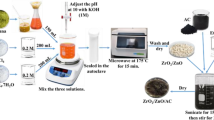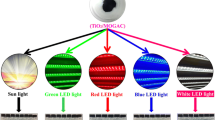Abstract
A novel titanium dioxide/activated carbon (TiO2/AC) composite where AC derived from oil palm empty fruit bunch (EFB) was synthesised by using sol–gel method. All the samples were characterised by using X-ray diffraction (XRD), scanning electron microscopy-energy dispersive X-ray (SEM-EDX), Fourier transformed infrared (FTIR), thermogravimetric analysis (TGA) and surface analyser. SEM analysis showed that TiO2 particles were successfully embedded and well distributed on the AC surface. The elemental composition analysis found that the TiO2/AC composite contained titanium (Ti), oxygen (O) and carbon (C) atoms. Meanwhile, the appearance of new band at about 960 cm−1 which assigned to the Ti–O stretching was observed in the FTIR spectra when the AC was incorporated into TiO2. TGA analysis showed that the weight loss of 32 wt.% from 150 to 550 °C was due to the decomposition of amorphous carbon layers and loss of hydroxyl groups on TiO2. It was found that the TiO2/AC composite had better performance in the sonocatalytic degradation of malachite green as compared to the individual AC and TiO2 because the TiO2/AC composite had dual functionality and huge number of active sites which could promote the mass transfer of dye molecules towards catalyst surface. By using 1.5 g/L of TiO2/AC composite which calcined at 700 °C on 100 mL of 200 mg/L of malachite green at solution pH of 7, a degradation efficiency of 87.11% had been achieved after 30 min of ultrasonic irradiation. A lower chemical oxygen demand (COD) removal (81.75%) was observed because the structured dye molecules underwent mineralisation process during the sonocatalytic degradation to generate intermediate compounds. The TiO2/AC composite was able to be recycled and still achieved a high degradation efficiency of 76.78% after second catalytic cycle as compared to the fresh TiO2/AC composite with degradation efficiency of 87.11%. In conclusion, the TiO2/AC composite had high reusability and promising for practical applications in textile industry.













Similar content being viewed by others
References
Ahmad FMA, Hassan MA, Taufiq-Yap YH, Ibrahim ML, Othman MR, Ali AAM, Shirai Y (2017a) Production of methyl esters from waste cooking oil using a heterogeneous biomass-based catalyst. Renew Energy 114:638–643
Ahmad FMA, Hassan MA, Taufiq-Yap YH, Shirai Y, Hasan MY, Zakaria MR (2017b) Waterless purification using oil palm biomass-derived bioadsorbent improved the quality of biodiesel from waste cooking oil. J Clean Prod 165:262–272
Ahmad FB, Zhang Z, Doherty WOS, O’Hara IM (2019) The prospect of microbial oil production and applications from oil palm biomass. Biochem Eng J 143:9–23
Ahmedchekkat F, Medjram MS, Chiha M, Mahmoud Ali Al-bsoul A (2011) Sonophotocatalytic degradation of rhodamine B using a novel reactor geometry: effect of operating conditions. Chem Eng J 178:244–251
Bhavani R, Sivasamy A (2016) Sonocatalytic degradation of malachite green oxalate by a semiconductor metal oxide nanocatalyst. Ecotoxicol Environ Saf 134:403–411
Boujibar O, Souikny A, Ghamouss F, Achak O, Dahbi M, Chafik T (2018) CO2 capture using N-containing nanoporous activated carbon obtained from argan fruit shells. J Environ Chem Eng 6:1995–2002
Cai Z, Sun Y, Liu W, Pan F, Sun P, Fu J (2017) An overview of nanomaterials applied for removing dyes from wastewater. Environ Sci Pollut Res 24:15882–15904
Chen X, Liu D, Wu Z, Cravotto G, Wu Z, Ye B-C (2018) Microwave-assisted rapid synthesis of Ag-β-cyclodextrin/TiO2/AC with exposed facets for highly efficient naphthalene degradation under visible light. Catal Commun 104:96–100
Chenakin S, Kruse N (2018) Combining XPS and ToF-SIMS for assessing the CO oxidation activity of Au/TiO2 catalysts. J Catal 358:224–236
Dehghan S, Kakavandi B, Kalantary RR (2018) Heterogeneous sonocatalytic degradation of amoxicillin using ZnO@Fe3O4 magnetic nanocomposite: influential factors, reusability and mechanisms. J Mol Liq 264:98–109
El-Sheikh SM, Khedr TM, Hakki A, Ismail AA, Badawy WA, Bahnemann DW (2017) Visible light activated carbon and nitrogen co-doped mesoporous TiO2 as efficient photocatalyst for degradation of ibuprofen. Sep Purif Technol 173:258–268
Fan W, Chakraborty A, Kayal S (2016) Adsorption cooling cycles: insights into carbon dioxide adsorption on activated carbons. Energy 102:491–501
Gao F, Jiang J, Du L, Liu X, Ding Y (2018) Stable and highly efficient Cu/TiO2 nanocomposite photocatalyst prepared through atomic layer deposition. Appl Catal, A 568:168–175
Gar Alalm M, Tawfik A, Ookawara S (2016) Enhancement of photocatalytic activity of TiO2 by immobilization on activated carbon for degradation of pharmaceuticals. J Environ Chem Eng 4:1929–1937
Han X, Chu L, Liu S, Chen T, Ding C, Yan J, Cui L, Quan G (2015) Removal of methylene blue from aqueous solution using porous biochar obtained by KOH activation of peanut shell biochar. BioResources 10:2836–2849
Herawan SG, Hadi MS, Ayob MR, Putra A (2013) Characterization of activated carbons from oil-palm shell by CO2 activation with no holding carbonization temperature. Sci World J 2013:624865 (6 pages. https://doi.org/10.1155/2013/624865
Hossain MA, Ganesan PB, Sandaran SC, Rozali SB, Krishnasamy S (2017) Catalytic microwave pyrolysis of oil palm fiber (OPF) for the biochar production. Environ Sci Pollut Res 24:26521–26533
Hunge YM, Yadav AA, Mathe VL (2018) Ultrasound assisted synthesis of WO3-ZnO nanocomposites for brilliant blue dye degradation. Ultrason Sonochem 45:116–122
Khataee A, Kayan B, Gholami P, Kalderis D, Akay S (2017) Sonocatalytic degradation of an anthraquinone dye using TiO2-biochar nanocomposite. Ultrason Sonochem 39:120–128
Khataee A, Arefi-Oskoui S, Samaei L (2018) ZnFe-Cl nanolayered double hydroxide as a novel catalyst for sonocatalytic degradation of an organic dye. Ultrason Sonochem 40:703–713
Lai CW, Abd Hamid SB, Sreekantan S (2013) A novel solar driven photocatalyst: well-aligned anodic WO3 nanotubes. Int J Photoenergy 2013:1–6
Lee XJ, Lee LY, Gan S, Thangalazhy-Gopakumar S, Ng HK (2017) Biochar potential evaluation of palm oil wastes through slow pyrolysis: thermochemical characterization and pyrolytic kinetic studies. Bioresour Technol 236:155–163
Li M, Zhang X, Liu Y, Yang Y (2018) Pr3+ doped biphasic TiO2 (rutile-brookite) nanorod arrays grown on activated carbon fibers: hydrothermal synthesis and photocatalytic properties. Appl Surf Sci 440:1172–1180
Mahlia TMI, Ismail N, Hossain N, Silitong AS, Shamsuddin AH (2019) Palm oil and its wastes as bioenergy sources: a comprehensive review. Environ Sci Pollut Res. Article in press 1–18
Martins AC, Cazetta AL, Pezoti O, Souza JRB, Zhang T, Pilau EJ, Asefa T, Almeida VC (2017) Sol-gel synthesis of new TiO2/activated carbon photocatalyst and its application for degradation of tetracycline. Ceram Int 43:4411–4418
Miao J, Zhang R, Zhang L (2018) Photocatalytic degradations of three dyes with different chemical structures using ball-milled TiO2. Mater Res Bull 97:109–114
Mishra S, Maiti A (2018) The efficacy of bacterial species to decolourise reactive azo, anthroquinone and triphenylmethane dyes from wastewater: a review. Environ Sci Pollut Res 25:8286–8314
Mopoung S, Moonsri P, Palas W, Khumpai S (2015) Characterization and properties of activated carbon prepared from tamarind seeds by KOH activation for Fe(III) adsorption from aqueous solution. Sci World J 2015:1–9
Muhd Julkapli N, Bagheri S, Bee Abd Hamid S (2014) Recent advances in heterogeneous photocatalytic decolorization of synthetic dyes. Sci World J 2014:1–25
Nasar A, Mashkoor F (2019) Application of polyaniline-based adsorbents for dye removal from water and wastewater—a review. Environ Sci Pollut Res 26:5333–5356
Niu X, Du YE, Liu Y, Qi H, An J, Yang X, Feng Q (2017) Hydrothermal synthesis and formation mechanism of the anatase nanocrystals with co-exposed high-energy {001}, {010} and [111]-facets for enhanced photocatalytic performance. RSC Adv 7:24616–24627
Saleh TA, Gupta VK (2011) Functionalization of tungsten oxide into MWCNT and its application for sunlight-induced degradation of rhodamine B. J Colloid Interface Sci 362:337–344
Sharma A, Lee B-K (2017a) Growth of TiO2 nano-wall on activated carbon fibers for enhancing the photocatalytic oxidation of benzene in aqueous phase. Catal Today 287:113–121
Sharma A, Lee B-K (2017b) Photocatalytic reduction of carbon dioxide to methanol using nickel-loaded TiO2 supported on activated carbon fiber. Catal Today 298:158–167
Sing KSW, Everett DH, Haul RAW, Moscou L, Pierotti RA, Rouquerol J, Siemieniewska T (1985) Reporting physisorption data for gas/solid systems with special reference to the determination of surface area and porosity. Pure Appl Chem 57:603–619
Su X-L, Li S-H, Jiang S, Peng Z-K, Guan X-X, Zheng X-C (2018) Superior capacitive behavior of porous activated carbon tubes derived from biomass waste-cotonier strobili fibers. Adv Powder Technol 29:2097–2107
Talero G, Rincón S, Gómez A (2019) Biomass torrefaction in a standard retort: a study on oil palm solid residues. Fuel 244:366–378
Tian F, Wu Z, Tong Y, Wu Z, Cravotto G (2015) Microwave-assisted synthesis of carbon-based (N, Fe)-codoped TiO2 for the photocatalytic degradation of formaldehyde. Nanoscale Res Lett 10:360
Velasco LF, Guillet-Nicolas R, Dobos G, Thommes M, Lodewyckx P (2016) Towards a better understanding of water adsorption hysteresis in activated carbons by scanning isotherms. Carbon 96:753–758
Wang C-L, Hwang W-S, Chu H-L, Lin H-J, Ko H-H, Wang M-C (2016) Kinetics of anatase transition to rutile TiO2 from titanium dioxide precursor powders synthesized by a sol-gel process. Ceram Int 42:13136–13143
Wu H, Ma J, Zhang C, He H (2014) Effect of TiO2 calcination temperature on the photocatalytic oxidation of gaseous NH3. J Environ Sci 26:673–682
Acknowledgements
The authors wish to acknowledge the funding support of this work under the Fundamental Research Grant Scheme (FRGS/1/2018/TK10/UTAR/02/2) by the Ministry of Education (MOE) Malaysia and Universiti Tunku Abdul Rahman (UTAR) Research Fund (UTARRF/2018-C1/P01) through the Centre for Environment and Green Technology (CEGT) and Centre for Photonics and Advanced Materials Research (CPARM).
Author information
Authors and Affiliations
Corresponding author
Additional information
Responsible editor: Suresh Pillai
Publisher’s note
Springer Nature remains neutral with regard to jurisdictional claims in published maps and institutional affiliations.
Rights and permissions
About this article
Cite this article
Pang, Y.L., Lim, S. & Lee, R.K.L. Enhancement of sonocatalytic degradation of organic dye by using titanium dioxide (TiO2)/activated carbon (AC) derived from oil palm empty fruit bunch. Environ Sci Pollut Res 27, 34638–34652 (2020). https://doi.org/10.1007/s11356-019-05373-x
Received:
Revised:
Accepted:
Published:
Issue Date:
DOI: https://doi.org/10.1007/s11356-019-05373-x




